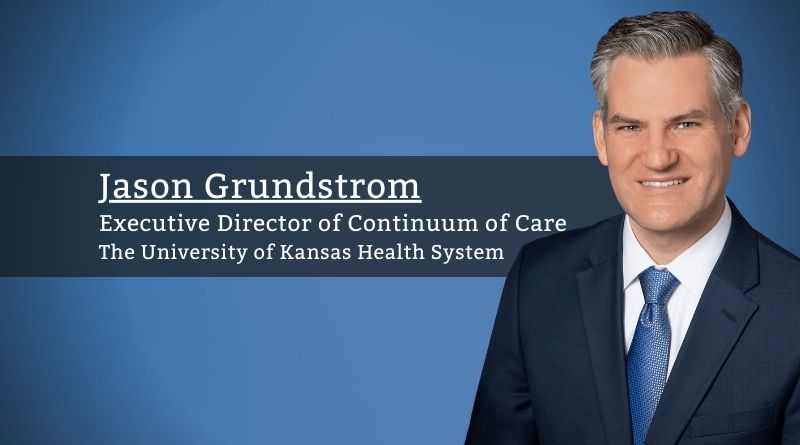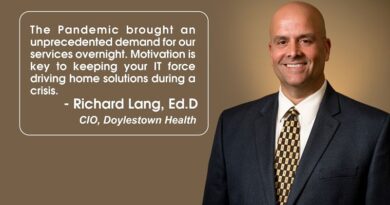The University of Kansas Health System Addressing Care Gaps with Telehealth
By Jason Grundstrom, Executive Director of Continuum of Care, The University of Kansas Health System
The University of Kansas Health System, along with the University of Kansas, has been a pioneer in telemedicine for more than thirty years. In the months leading up to the pandemic, it was typical for our providers to see around 100 patients per month. We specialized in telestroke, telebehavioral health and telecancer throughout the state of Kansas. The laws at the time limited our providers and patients to being physically in a clinic space in order to give and receive telehealth care. Like most health organizations, the pandemic accelerated the demand for telehealth. At the height of the pandemic, our providers gave care to more than 1,200 patients daily. Today, our telehealth volume has leveled off to 600 patients a day. To meet the initial demand, 2500 plus employees pivoted from their regular duties to help with the implementation of software, hardware, testing and education in order to bring providers, support staff and patients up to speed on the new technologies.
A few months into the pandemic, we expanded our telehealth capabilities by offering virtual urgent care, grew our asynchronous care offerings and created a remote patient monitoring (RPM) department. Our digital care interactions with patients totaled more than 1.7 million last year alone. Within the last three years, we have witnessed a paradigm shift in which more and more of our patients have come to expect a menu of offerings to receive their care beyond in-person and many of them want to do so in the comfort of their home. We calculated last year alone, we collectively saved our patients 2.5 million miles of driving, countless hours of time off from work, extra childcare, hotel expenses etc. Additionally, we noticed a positive impact on missed appointments. A challenge, of course, is balancing patients’ expectations of wanting to do many things digitally. One example is reconciling with physicians accustomed to seeing the first patient encounters in person…not via telehealth. While our numbers speak of great success, it has been challenging helping patients understand why, some care necessitates they come in and encouraging providers to offer virtual care. Initially, to promote telehealth and build confidence among providers, our telehealth department went on a sort of roadshow to all our departments touting the benefits of telehealth, i.e., fewer canceled appointments, ability to deliver care sooner, increased patient satisfaction, etc. We learned; however, this approach did not yield the success we were hoping to achieve by increasing the number of specialties offering telehealth. Word of mouth by champion providers was ultimately the key to showcasing the power of telehealth. As they promoted the benefits of telehealth to their colleagues, our email inboxes filled up and phones started ringing. Today, our team continues to partner alongside more and more specialties to develop workflows designed to free up in-person appointments for higher acuity patient appointments and safely move more patients to our virtual options. Another benefit of telehealth has been building relationships throughout Kansas and Missouri by allowing patients to stay hospitalized in their community while having access to our specialized care as needed.
Telehealth helps close the access gaps to all patients, no matter where they live.
Something worth noting is how the temporary relaxing of several federal and state laws along with private payor policies helped break down barriers to telehealth which limited telehealth to certain providers within a certain geography in order for providers to be reimbursed. While these geographic restrictions were designed to give patients access to hard-to-reach services in rural areas in our country, patients in very urban settings also can experience situations which limit their ability to see a provider. Telehealth helps close the access gaps to all patients, no matter where they live. As we move forward, we are continuing to work with federal and state lawmakers to encourage codifying some of the temporary relaxation of laws into permanency including the important extensions within the Consolidated Appropriations Act of 2023 and CMS’s physician fee schedule. Just as important are the parity laws in which states hold the power to mandate. Hospitals which offer telehealth as a part of their care options do not have the cost savings as standalone telehealth companies. Hospital-based telehealth programs still have the overhead costs in order to provide both in-person and telehealth care. The concerns are providers will eventually become frustrated with the lower reimbursement and change back to more in-person, higher reimbursable encounters. From a policy standpoint, there is a need for caution to consider this when changing and applying reimbursement policies unilaterally to all telehealth care. It has been encouraging to see how our involvement in writing several bills and policies has been presented for debate at the federal and state levels, as well as policy changes with our private payors. As the Public Health Emergency (PHE) for COVID-19 continues to be further behind us and other issues work their way to the top of our policymakers list, the temporary gains accomplished in expanding telehealth are meeting some headwinds.



